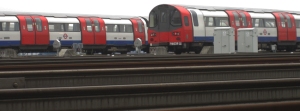I don’t use the term “best day of my life” often, but in this instance it’s pretty accurate.
I was lucky enough to get tickets to go to a London Underground Jubilee line depot – Stratford Market Depot – during Open House London 2013, and it was a wonderful experience.
The day was particularly sweet and well handled from a PR point of view. The tours were well organised and, brilliantly, were led by the people actually working at the depot on the trains. They were enthusiastic, and it was clear to see they took pride in the amazing work the depot does on a daily basis. They were happy to answer any questions, and were equally happy to contribute both interesting and amusing stories. Oh, and also you get to wear an Underground High-Vis vest.

In rare open house form, every person who visited was given a 35 guide book which detailed every fact you could ever need or want to know about Stratford Market depot, including a very good history of the site. We also were given a goody bag with a lovely mug and pen set from Stratford Market!
Below are some photos of the experience.
How brilliant is this sign’s totally accurate drawing of a tube train? (Below)
The trains traveling on the line are 1996 tube stock, most of which now have the Olympic seat pattern in the cars given the line’s service into the Olympic Stadium.
How to exit the tube in an emergency situation if it’s in a tunnel!
The site of the depot had remains dating back to Roman Farms and Saxon ditches. In 1135 St. Mary’s Abbey (later Langthorne Abbey) was founded at the south end of the depot, and there it remained until 1538, when it was closed as part of Henry VIII’s dissolution of monasteries across Britain. Some of the remains are still reportedly carefully covered up on site.
The next time in history that the site pops up is in the 1840s, when the North Woolwich Railway was built, and then in 1879 the Stratford Market was established and remained in situ until 1991.
After that point, the old railway depot was demolished and the area examined by archaeologists before the new, current, depot for the Jubilee line was built in connection with the extension of the Jubilee line. It opened in 1996 and serves to maintain and repair trains as well as to ‘stable’ them.
The sheer volume of trains going in and out of the depot is astounding, and when seeing the inner workings, it becomes easy to see why even the smallest of delays has such strong knock-on affects across the entirety of the line. The tiniest delay can stop the right train being in the right place at the right time, which can make it excessively difficult to schedule in planned maintenance for every train on the network.
The turnaround time on some train repairs is exhausting to think about, given that often the depot only has the time in between morning and evening rush hour to adequately service the trains.
Here are some fun facts and figures about the Jubilee line from the information pack– which was put together in 2008, so don’t be too harsh if some bits have changed:
The line length from Stanmore to Stratford is 36.2km
Average tunnel depths are 15 metres to 30 metres
Average journey time between stations is 2.1 minutes
The fleet holding is 63 7-car trains
171 m people per year travel on the line














Hi Emily,
I have a shock for you. As you are so passionate for tube trains, your selfie will be used as the back drop to the login screen for the bms pc. Every time some one goes to login on the bms system your smile will be the first thing they see. How did this happen… I searched for SMD images and your blog came up in the search. You are now part of SMD. This has been agreed with the depot manager. The BMS system runs the environmental systems including heating and cooling but not signals or power supplies. However the BMS system is still important but not regarded as critical unless the HV transformers fail due to over heat. That said, your picture will be on the system for a minimum of 20 years
Regards
Rob